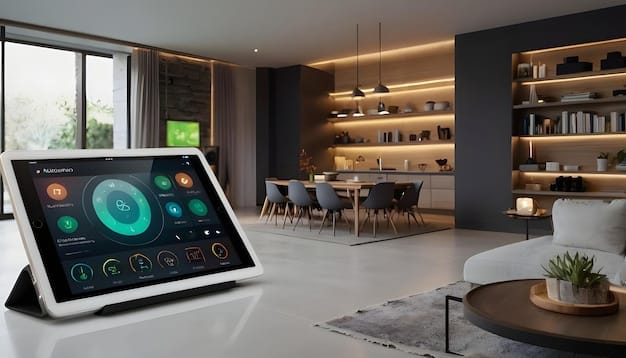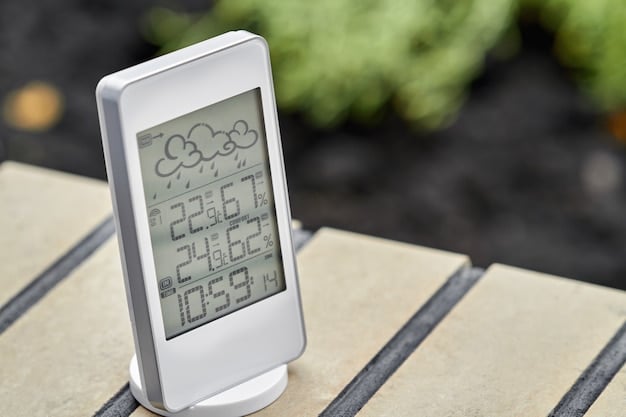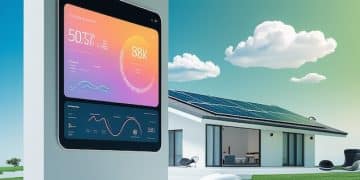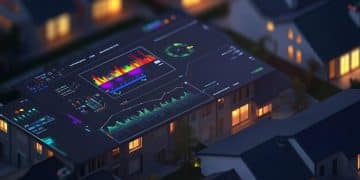Smart Home Tech: 2025’s Hottest & Outdated Innovations

Anúncios
From AI-driven automation to sustainable energy integration, smart home technology in 2025 is reshaping daily life by offering enhanced efficiency, comfort, and security, while older, less integrated systems fade into obsolescence.
The landscape of home technology is in constant flux, evolving at a dizzying pace. As we step into 2025, discerning what’s truly innovative and what’s become obsolete in the realm of smart home tech is crucial for consumers and industry insiders alike. This guide explores the cutting-edge advancements and the outdated devices, helping you navigate the future of smart living.
Understanding the Smart Home Evolution
The concept of a smart home has moved far beyond simple voice assistants and automated lights. In 2025, it’s about a deeply integrated ecosystem that anticipates needs, optimizes energy, and provides unparalleled convenience. What was once considered sci-fi is now a tangible reality, pushing the boundaries of how we interact with our living spaces. This evolution emphasizes seamless communication between devices and increasingly sophisticated AI capabilities.
From Automation to Autonomy
Early smart homes focused on basic automation—turning lights on at a set time or adjusting thermostats. Now, the emphasis has shifted to autonomy. Systems are designed to learn habits, adapt to environmental changes, and even perform predictive maintenance, minimizing human intervention. This level of intelligence transforms a house into a truly responsive partner, optimizing comfort and efficiency without constant manual input.
- Predictive Maintenance: Smart appliances now anticipate issues, ordering parts or scheduling service autonomously.
- Personalized Environments: AI adjusts lighting, temperature, and even air quality based on individual preferences and presence.
- Energy Optimization: Systems learn peak usage times and adjust power consumption to minimize bills and environmental impact.
The Rise of Interoperability Standards
A significant hurdle in the past was the lack of universal communication standards, leading to fragmented smart home setups. However, 2025 sees the strong emergence of robust interoperability protocols. This means devices from different manufacturers can finally “speak” to each other effortlessly, creating a truly unified smart home experience. No more isolated gadgets; everything works together harmoniously.
The shift towards open standards like Matter and Thread has democratized the smart home market, making it easier for consumers to build sophisticated systems without being locked into a single brand. This fosters innovation and competition, benefiting the end-user with more choices and better-performing products. Manufacturers are now designing with universal compatibility in mind, a stark contrast to the proprietary systems of yesteryear.
For example, a smart lock from one company can now seamlessly trigger lights from another brand and adjust the thermostat from a third, all through a single command or automated routine. This level of integration was once a dream but is now a core expectation for smart home tech, significantly improving user experience and overall system reliability.
What’s Hot in Smart Home Tech for 2025
The cutting edge of smart home technology in 2025 is defined by unparalleled intelligence, sustainable integration, and a focus on holistic well-being. These advancements are not just about convenience; they are about creating environments that actively enhance our lives. From invisible interfaces to energy-positive systems, the future is incredibly exciting and deeply interconnected.
AI-Powered Home Assistants and Contextual Intelligence
Voice assistants have matured dramatically, transitioning from simple command processors to sophisticated AI companions. In 2025, these assistants possess “contextual intelligence,” meaning they understand more than just your words; they grasp your intent, habits, and even emotional state to provide truly personalized assistance. They can anticipate your needs before you utter a command.
Instead of merely turning on lights, an AI assistant might observe your evening routine, suggest winding down activities, or even recommend meal options based on fridge contents and dietary preferences. These systems learn and adapt in real-time, making daily life incredibly seamless. Their ability to infer user needs from various data points—like calendar events, wearable data, and home occupancy patterns—sets them apart.
This level of intelligence extends to proactive problem-solving. Imagine your assistant noticing a slight anomaly in your energy usage, cross-referencing it with historical data, and suggesting a maintenance check for a specific appliance, all before a major issue arises. This predictive capacity is a cornerstone of 2025’s smart home, moving from reactive to genuinely predictive support.
Advanced Health and Wellness Integration
Our homes are becoming extensions of our personal health and wellness regimes. Smart home tech in 2025 incorporates sophisticated sensors and AI to monitor air quality, sleep patterns, stress levels, and even vital signs, providing actionable insights for improving well-being. This is particularly relevant in an era where health consciousness is paramount.
- Ambient Health Monitoring: Non-intrusive sensors track breathing, heart rate, and sleep quality without wearables.
- Air Quality Management: Systems automatically purify air based on particulate matter, VOCs, and CO2 levels.
- Stress-Reducing Environments: Lighting and soundscapes adapt to promote relaxation or alertness, influenced by biometric feedback.
This integration isn’t just about data collection; it’s about responsive environments. If a sensor detects an increase in air pollution, the ventilation system might automatically activate. If your sleep quality is poor, the smart bed might subtly adjust its firmness, or the lighting system could suggest a more conducive wake-up routine. The home becomes a proactive guardian of your health.
Sustainable and Energy-Positive Solutions
With growing environmental concerns, smart homes are leading the charge in sustainability. The hottest technologies in 2025 prioritize energy efficiency and even energy generation. Think integrated solar panels coupled with smart battery storage, intelligent grid optimization, and hyper-efficient appliances that minimize waste. Homes are becoming net energy producers.
These systems dynamically manage energy consumption, shifting usage to off-peak hours and optimizing the use of renewable energy sources. This not only reduces carbon footprint but also significantly lowers utility bills. Furthermore, intelligent water management systems minimize waste, detecting leaks and optimizing irrigation based on real-time weather data.

The Disappearing Tech: What’s Not in 2025
Just as some technologies soar, others inevitably fade, becoming less relevant or even obsolete. In 2025, several smart home concepts and devices that once seemed promising are now considered outdated or simply not worth the investment. Understanding this helps consumers avoid pitfalls and embrace truly future-proof solutions.
Standalone, Single-Function Devices
The era of single-function smart devices that don’t communicate with anything else is rapidly coming to an end. Remember the smart plug that only turned on one lamp and couldn’t integrate with a wider system? Those are now firmly in the “not” category. Consumers demand holistic ecosystems, not isolated gadgets.
The market has matured beyond novelty items; now, value is placed on interoperability and multifunctionality. A device that performs only one task, poorly integrated into a larger system, is seen as inefficient and cumbersome. This applies to everything from basic light bulbs that lack color customization to rudimentary door sensors that can’t trigger broader security protocols.
Proprietary & Closed Ecosystems
While some brands built strong walled gardens in the early days, consumers in 2025 are actively rejecting proprietary ecosystems that limit choice and interoperability. Technologies that locked users into a single brand for all their smart home needs are rapidly losing appeal. The future is open, collaborative, and consumer-centric.
This shift is driven by frustration with compatibility issues and the desire for flexibility. Why invest in a system that won’t work with your next heating unit or a different brand of smart speaker? The drive towards universal standards like Matter has sounded the death knell for stubbornly closed systems, forcing manufacturers to adapt or risk irrelevance.
Obtrusive and Overly Complex Interfaces
Gone are the days when a smart home meant a wall filled with a multitude of switches and complex touch screens. The trend in 2025 is towards invisible technology and intuitive, natural interfaces. If a device requires a manual, lengthy setup process, or a dedicated app for every single function, it’s considered outdated.
The goal is seamless integration into daily life, not added layers of complexity. Voice commands, gesture controls, and even predictive AI that anticipates needs reduce the reliance on explicit manual inputs. Smart homes should simplify, not complicate.
Security and Privacy in a Connected World
As our homes become smarter, the implications for security and privacy grow exponentially. In 2025, these concerns are paramount, driving innovation in data protection and user control. It’s no longer just about locking the front door; it’s about securing your digital footprint within your living space.
Enhanced Cybersecurity for Smart Devices
The vulnerabilities of early smart devices were a significant concern. However, breakthroughs in encryption, secure boot protocols, and automatic firmware updates have made smart homes vastly more resilient to cyber threats. Manufacturers are now held to higher standards, implementing best practices from the ground up, not as afterthoughts.
This includes mandatory two-factor authentication, anonymized data collection where possible, and robust network segmentation to isolate devices and minimize potential attack surfaces. Consumers are more educated about these risks, demanding transparency and strong security features as a baseline. The industry recognizes that trust is built on reliability and protection.
User Control Over Data and Permissions
Privacy is not just about protection from external threats; it’s about giving individuals granular control over their own data. In 2025, smart home platforms offer unparalleled transparency and user control regarding data collection and sharing. You can easily see what data is being collected, how it’s used, and revoke permissions at any time.
- Dashboard Transparency: Comprehensive dashboards show all collected data and its usage in real-time.
- Granular Permissions: Users can set specific permissions for each device and application, limiting data access.
- Data Anonymization: Increased use of on-device processing and anonymized data to protect personal identity.
This shift empowers users, transforming them from passive data subjects to active managers of their personal information. Regulations like GDPR and CCPA have also played a crucial role in pushing manufacturers towards more privacy-centric designs, fostering a more ethical approach to data handling.
The Future of Smart Home Living Beyond 2025
Looking beyond 2025, the trajectory of smart home technology points towards even deeper integration with urban infrastructure, profound personalized experiences, and an emphasis on environmental resilience. The home will evolve from a static structure into a dynamic, adaptive entity.
Hyper-Personalization and Adaptive Environments
The next frontier is hyper-personalization, where the home doesn’t just respond to your presence but anticipates your mood, energy levels, and even cognitive states. Imagine a home that subtly shifts lighting, ambient sounds, and even scent profiles to enhance focus for work, promote relaxation, or aid sleep, all based on biometric data and learned preferences.
These environments will be fluid, adapting in real time to the occupants’ changing needs and external stimuli. This goes beyond simple automation; it’s about creating a living space that is truly an extension of the individual, intuitively supporting their well-being and productivity without conscious effort. The home becomes a personalized sanctuary tailored to every nuanced aspect of life.
Integration with Smart Cities and Infrastructure
The smart home will not exist in isolation but will become a node within a broader smart city ecosystem. This means seamless communication with external infrastructure—from smart grids managing energy demand to autonomous vehicles coordinating commutes, and public services providing real-time data on air quality or traffic patterns. The home becomes a connected point in a larger intelligent network.
This integration promises optimized resource management, reduced congestion, and enhanced public safety. For example, your smart home might adjust your commute schedule based on city-wide traffic data or pre-cool your house when it anticipates an energy surplus from the grid. This holistic vision blurs the lines between private dwelling and public infrastructure, creating a truly interconnected future.

Resilience and Self-Sufficiency
Given increasing concerns about climate change and energy independence, smart homes will prioritize resilience and self-sufficiency. This includes advanced off-grid capabilities, robust energy storage solutions, and the integration of diverse renewable energy sources. Homes will be designed to withstand extreme weather events and maintain functionality during outages.
Furthermore, future smart homes will integrate advanced water recycling systems, vertical gardens for food production, and materials that adapt to environmental conditions, such as dynamic insulation. The goal is to create living spaces that are not only comfortable and convenient but also robust guardians of their inhabitants, minimizing reliance on external systems and maximizing sustainability.
Navigating Your Smart Home Journey
Embarking on or upgrading your smart home journey in 2025 requires a strategic approach. It’s no longer just about buying the latest gadget; it’s about creating a cohesive, future-proof ecosystem that genuinely enhances your lifestyle. Understanding the current trends and obsolescence patterns is vital for making informed decisions and avoiding costly mistakes.
Strategic Planning and Scalability
Before investing in new smart home technology, a well-defined plan is essential. Consider your long-term goals: Are you prioritizing energy efficiency, security, convenience, or a combination? Focusing on interoperable systems from the outset ensures scalability, allowing you to gradually expand your smart home without encountering compatibility issues later on. Think about future needs and how new devices might integrate.
Investing in a robust central hub capable of supporting multiple protocols (e.g., Matter, Thread, Wi-Fi) provides a strong foundation. Prioritizing devices that offer local processing capabilities, reducing reliance on cloud services, can also enhance reliability and responsiveness. This foresight prevents the frustration of having a collection of isolated smart gadgets rather than a truly integrated home.
Prioritizing Security and Privacy
With every new connected device introduced into your home, the attack surface for cyber threats increases. Therefore, security and privacy must be non-negotiable priorities. Always opt for devices from reputable manufacturers that have a track record of regular security updates and transparent privacy policies. Read reviews specifically addressing security features.
Regularly update firmware for all smart devices, use strong, unique passwords, and consider network segmentation to isolate sensitive devices. Educate yourself on the data each device collects and manage permissions proactively. A secure smart home is a foundational pillar of its value and peace of mind. Without robust security, the conveniences offer hollow benefits.
Embracing Sustainability and Efficiency
The future of smart homes is inextricably linked to sustainability. As you make purchasing decisions, prioritize devices with strong energy efficiency ratings and those that integrate seamlessly with renewable energy sources like solar. Look for features that allow for intelligent energy management, such as automated climate control based on occupancy or dynamic load balancing for appliances.
Consider products made from recycled materials or those with a clear commitment to environmental stewardship. Investing in water-saving smart systems, from leak detectors to intelligent irrigation, also contributes to a more sustainable household. A smart home in 2025 is not just about automating tasks; it’s about making conscious choices that benefit both your wallet and the planet.
| Key Trend | Brief Description |
|---|---|
| 🏡 AI Autonomy | Homes predict needs, learn habits, and self-optimize for comfort and efficiency. |
| 🌱 Sustainability Focus | Energy-positive solutions like advanced solar and smart grid integration. |
| ✨ Invisible Tech | Seamless integrations, natural interfaces, and disappearing controls. |
| 📉 Obsolete: Standalone | Single-function, non-interoperable gadgets are fading out. |
Frequently Asked Questions About Smart Home Tech in 2025
In 2025, the most significant advancements include truly autonomous AI assistants that learn and adapt, deep integration of health and wellness monitoring systems, and pervasive sustainable energy solutions. Interoperability via universal standards like Matter also enables seamless communication across diverse devices, creating truly unified ecosystems.
Standalone smart devices are becoming obsolete because consumers prioritize integrated, cohesive ecosystems over isolated gadgets. Devices that don’t communicate with other household technologies create fragmentation and reduce overall efficiency. The demand is now for smart homes where all components work harmoniously to provide a unified, intelligent experience.
Sustainability is critically important in 2025 smart homes, driven by environmental consciousness and the desire for energy independence. New technologies integrate renewable energy sources, optimize consumption, and reduce waste, allowing homes to minimize their carbon footprint and even become net energy producers. This focus on efficiency benefits both the planet and the homeowner’s utility bills.
Privacy is a key focus in 2025 smart home tech, with manufacturers offering enhanced user control over data. This includes transparent dashboards for monitoring data collection, granular permission settings for individual devices, and increased reliance on on-device processing to minimize cloud-based data transfer. Robust cybersecurity measures are also implemented to protect sensitive information.
Beyond 2025, smart homes will likely evolve towards hyper-personalization, with environments adapting to individual moods and cognitive states. We can also expect deeper integration with smart city infrastructures, connecting homes to broader urban systems. Furthermore, increased emphasis on self-sufficiency and resilience, including advanced off-grid capabilities, will define future smart living spaces.
Conclusion
The rapid evolution of smart home technology by 2025 underscores a clear shift towards truly intelligent, integrated, and sustainable living spaces. As outdated, single-function devices and closed ecosystems fade, the future embraces AI autonomy, advanced health integration, and energy-positive solutions. Navigating this landscape requires a strategic approach, prioritizing interoperability, robust security, and a commitment to sustainability, ensuring your home is not just smart, but truly future-proof and beneficial for all its occupants.





